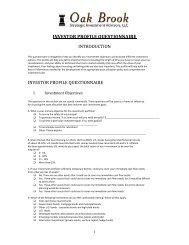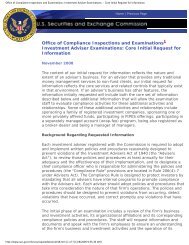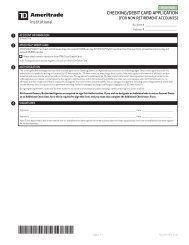Mind Mapping, - AdvisorFlex
Mind Mapping, - AdvisorFlex
Mind Mapping, - AdvisorFlex
Create successful ePaper yourself
Turn your PDF publications into a flip-book with our unique Google optimized e-Paper software.
<strong>Mind</strong> <strong>Mapping</strong>,<br />
a Simple Yet Powerful Tool for You and Your Clients<br />
<strong>Mind</strong> <strong>Mapping</strong> – what is it?<br />
<strong>Mind</strong> <strong>Mapping</strong> is a technique that engages both sides of the brain for a powerful<br />
way to improve one’s thinking skills. Michael Gelb, Founder and President of High<br />
Performance Learning, in the foreward of Joyce Wycoff’s book, <strong>Mind</strong>mapping, describes<br />
<strong>Mind</strong> <strong>Mapping</strong> as follows:<br />
“<strong>Mind</strong>mapping was developed in the early 1970’s by Tony Buzan as a tool to help people<br />
take notes more effectively. As he applied the tool, he realized that he had discovered<br />
not just a better way of note taking, but a new and powerful means of improving his<br />
students’ thinking skills.<br />
The value of mindmapping is perhaps best understood in contrast with the technique<br />
most of us learned for generating our ideas and taking notes: the traditional outline.<br />
However, outlining demands that we order ideas before giving free reign to the process<br />
of idea generation, thereby interfering with the speed and range of our idea production.<br />
Our brains possess unlimited potential for idea generation. They work best when we<br />
allow our ideas to flow freely before attempting to organize. While numerous non linear<br />
note taking systems have evolved to free the mind to generate ideas before having to<br />
organize them, mindmapping provides a systematic means for recording and<br />
encouraging the natural flow of the thinking process by creating a ‘positive feedback<br />
loop’ between brain and notes.<br />
Try this: Think about the last book you read and imagine that you have to write a<br />
report on it. As you begin to recall ideas, you will probably not see a formal outline in<br />
your mind’s eye. Rather, you get key words, associations, pictures and images that<br />
seem to ‘float up to consciousness.’ In order to produce your report, you will ultimately<br />
have to organize these streams of association.<br />
In addition to enhancing the freedom of association, mindmapping provides an<br />
innovative, comprehensive approach to idea organization. Many of our students<br />
comment that mindmapping seems natural, that they’ve devised their own note taking<br />
system involving images, colors and key words that approximate mindmapping. They<br />
are thrilled to discover that their own intuitions have been developed and systemized in<br />
a way that allows them to explore new dimensions of flexibility and precision of<br />
thought.”
Wikepedia states the following on the subject of mind mapping:<br />
“A mind map is a diagram used to represent words, ideas, tasks or other items linked<br />
to and arranged radially around a central key word or idea. It is used to generate,<br />
visualize, structure and classify ideas, and as an aid in study, organization, problem<br />
solving, and decision making.<br />
It is an image-centered diagram that represents semantic or other connections between<br />
portions of information. By presenting these connections in a radial, non-linear graphical<br />
manner, it encourages a brainstorming approach to any given organizational task,<br />
eliminating the hurdle of initially establishing an intrinsically appropriate or relevant<br />
conceptual framework to work within.<br />
A mind map is similar to a semantic network or cognitive map but there are no formal<br />
restrictions on the kinds of links used.<br />
Most often the map involves images, words, and lines. The elements are arranged<br />
intuitively according to the importance of the concepts and they are organized into<br />
groupings, branches, or areas. The uniform graphic formulation of the semantic<br />
structure of information on the method of gathering knowledge, may aid recall of<br />
existing memories.<br />
<strong>Mind</strong> maps (or similar concepts) have been used for centuries, for learning,<br />
brainstorming, memory, visual thinking, and problem solving by educators, engineers,<br />
psychologists and people in general. Some of the earliest examples of mind maps were<br />
developed by Porphyry of Tyros, a noted thinker of the 3rd century as he graphically<br />
visualised the concept categories of Aristotle. Ramon Llull also used these structures of<br />
the mind map form.<br />
People have been using image-centered radial graphic organization techniques referred<br />
to variably as mental or generic mind maps for centuries in areas such as engineering,<br />
psychology, and education, although the claim to the origin of the mind map has been<br />
made by a British popular psychology author, Tony Buzan. He claimed the idea was<br />
inspired by Alfred Korzybski's general semantics as popularized in science fiction novels,<br />
such as those of Robert A. Heinlein and A. E. van Vogt. He argues that 'traditional'<br />
outlines rely on the reader to scan left to right and top to bottom, whilst what actually<br />
happens is that the brain will scan the entire page in a non-linear fashion. He also uses<br />
popular assumptions about the cerebral hemispheres in order to promote the exclusive<br />
use of mind mapping over other forms of note making.<br />
… <strong>Mind</strong> maps have many applications in personal, family, educational, and business<br />
situations, including notetaking, brainstorming (wherein ideas are inserted into the map<br />
radially around the center node, without the implicit prioritization that comes from<br />
hierarchy or sequential arrangements, and wherein grouping and organizing is reserved<br />
for later stages), summarizing, revising and general clarifying of thoughts. For example,<br />
one could listen to a lecture and take down notes using mind maps for the most<br />
important points or keywords. One can also use mind maps as a mnemonic technique or
to sort out a complicated idea. <strong>Mind</strong> maps are also promoted as a way to collaborate in<br />
colour pen creativity sessions.<br />
Some of the literature around mind-mapping has made claims that one can find the<br />
perfect lover, combat bullying, persuade clients, develop intuitive powers, create global<br />
harmony, and tap the deeper levels of consciousness by using mind map techniques.”<br />
So what does <strong>Mind</strong> <strong>Mapping</strong> look like? To show you how easy this is, and how it<br />
can be used for almost anything, let’s imagine we’re going to plant a garden in the<br />
backyard. Our title is “garden.” You take a plain piece of paper and put the main topic,<br />
“garden,” in a circle in the middle of the page.<br />
You then want to decide what you would like to plant in your garden. With “garden”<br />
being the title, off of this you will create “main topics.” It could look like this:
A mind map would include topics and subtopics as you get more detailed in your<br />
thinking. Each main topic would be a different item that you would want to plant in<br />
your garden. A finished map, with main topics and subtopics would look like this:
A more elaborate, more artistic version of a mind map could look like this:<br />
Source: http://www.peterussell.com/indexmap.gif<br />
That’s it! Any topic you want to mind map goes in the middle of the page, main topics<br />
are drawn in any fashion off of the title of your topic, with branches then being drawn<br />
for each layer where you want to go deeper.<br />
There are no wrong mind maps. However, keep in mind as you begin this<br />
process that it’s important to write down every idea that pops into your head without<br />
censure. If you are thinking that something doesn’t belong or isn’t appropriate you can<br />
get stuck and block the creative flow of ideas. You can always modify and make<br />
judgments about the items on the map after it’s done, but during the process just let<br />
ideas flow.<br />
Also, it helps in the beginning to use plain, unlined paper, the larger the size the<br />
better. We’re so used to using 8½ X 11 lined paper, that breaking out of that mold<br />
alone can help us tap into our creativity. Feel free to use a whiteboard and markers, or<br />
large drawing paper and colored pencils. Or use colored paper; whatever feels best to<br />
you. Feel free to play with this a little and come up with your own style. It won’t take<br />
long to find your way.<br />
There are also numerous mind mapping software programs available now. I like<br />
making maps by hand. But I also like taking my maps and client’s maps, with their<br />
permission, and re-creating them in the software so we can easily make changes over<br />
time. You may need to try these programs to see if they will work for you. Some offer
a free trial period. But it’s not mandatory that you use software. In many cases, again<br />
because we are so used to working on the computer, breaking away and making<br />
colorful maps by hand can really enhance our creativity and idea generation. You’ll just<br />
have to see what works best for you.<br />
Why is <strong>Mind</strong> <strong>Mapping</strong> so Powerful?<br />
Joyce Wycoff, in her book <strong>Mind</strong>mapping, states:<br />
“<strong>Mind</strong>mapping is a whole brain, visually interesting version of outlining. It has none of<br />
the constraints of outlining – you don’t have to follow a strict format of Roman<br />
numerals, capital letters, numbers, etc. Because mindmapping is not restrictive, your<br />
mind allows information to flow more freely. The information also organizes itself into<br />
clusters as it flows from the mind to the page.<br />
Recent brain/mind research has shown that the mind’s attention span is extremely short<br />
– between five and seven minutes depending upon subject matter and level of interest.<br />
The mind works best in these short bursts of activity. <strong>Mind</strong>mapping takes advantage of<br />
the tendency of the mind to work in short, intense ‘mind bursts’ by allowing you to<br />
‘dump’ your ideas and thoughts onto paper in just a few minutes.”<br />
I have used mind maps for everything from the preliminary stages of designing a<br />
home, to business plans, to taking notes with a client, and so much more. It’s really<br />
helped me unleash my creative side.<br />
How Can Your Use <strong>Mind</strong> <strong>Mapping</strong> In Your Work?<br />
<strong>Mind</strong> <strong>Mapping</strong> is a great way to prepare business plans, do strategic planning,<br />
create job descriptions, handle project management, make decisions, and tackle just<br />
about any problem solving task. I continue to find more and more ways to use mind<br />
mapping.<br />
Goal setting is another great way to use mind mapping. You can quickly map<br />
the different areas where goals need to be established and then decide what you want<br />
to accomplish. These maps can be big and colorful and posted somewhere in the office<br />
if you wish.<br />
To better engage your staff in your business, you can gather them together to<br />
do group mind mapping. Whether you are creating a job description for a new position
or are working on an operational issue, getting their input and having them help in the<br />
process can get them more involved which can help with staff retention. And just<br />
teaching your staff this process is of great value. They can apply the process in any<br />
area of their life, as can you.<br />
I have used mind mapping to identify all the tasks that need to be completed in<br />
my business, which of those tasks can only be handled by me, and which can be<br />
handled by staff. This exercise can help you achieve the life balance that most of us<br />
are striving for. By identifying and delegating the tasks that others can do, you free up<br />
more of your own time to spend in activities other than work.<br />
There are virtually unlimited ways to use mind mapping in your work. It may be<br />
worth spending a little time mind mapping all the ways you can use mind mapping to<br />
help you with the work you do.<br />
How Can <strong>Mind</strong> <strong>Mapping</strong> Strengthen Your<br />
Relationships With Your Clients?<br />
It’s been my experience that clients enjoy learning to mind map. It seems very<br />
non-threatening to them. There seems to be something that the client taps into during<br />
mind mapping that they don’t get to verbally in our meetings. According to the experts,<br />
this may be due to the fact that the process of mind mapping uses the whole brain, not<br />
just the parts that control analysis and communication. A result of this is, in virtually<br />
every instance where I have had a client mind map the answer to a question, even if<br />
we’ve discussed this same issue time and time again, I’ve learned something new which<br />
has helped strengthen our relationship.<br />
An example of where I have found mind mapping to be a great tool is in the area<br />
of retirement planning. There has been a lot of buzz in the financial planning<br />
community in the last few years about the changing face of retirement. In order to<br />
help clients get that “picture” of what their retirement may look like, I ask them a series<br />
of open ended questions and have them mind map the answers. Questions I have used<br />
include the following:<br />
• If money were not an issue, how would you want to spend your time?<br />
• If you knew you only had a limited amount of time to live, say 3-5 years,<br />
how would you want to spend that time?<br />
• What would an “ideal” retirement look like to you?<br />
• What things did you love doing when you were a child?<br />
• What things do you do where you lose all track of time doing them?
With married couples, I have each one create their own map. This brings out<br />
the individual interests of each person, along with where they have matching desires.<br />
Individually, perhaps the wife wants to continue to work, while the husband wants to<br />
play more golf, and together they may want to spend more time with their<br />
grandchildren, or travel, etc.<br />
I’ve also found that some clients have a very difficult time articulating answers to<br />
some questions. By mind mapping, and engaging both sides of the brain, the client can<br />
get to answers that they might not have come up with verbally. And they can get there<br />
quickly. This is not a long, drawn out process.<br />
This process has also helped with getting a handle on what their spending needs<br />
may be in retirement. Once we’ve uncovered how they want their retirement to look,<br />
we can project what their spending will need to be in order to accomplish their goals.<br />
Clients have found this process enlightening. It often uncovers some real<br />
passions they have that they may have put on the back burner. It also helps them get<br />
in touch with what is really important to them. I’ve experienced that our discussions<br />
then revolve more around their life, and less around their money. By the way, this<br />
same process also works well with clients already in retirement. It’s never too late to<br />
talk about what they’d like to do with the rest of their lives.<br />
With younger clients, rather than focusing on retirement, I ask them to mind<br />
map their “ideal life.” This could incorporate topics such as work, play, relationships,<br />
health, giving back, and spirituality or religion. We’ve created mind maps for each one<br />
of these subjects, and then a master mind map that is their “ideal life.” You can always<br />
add or subtract to this list, or come up with your own topics. My goal is to get the<br />
client thinking about their whole life. Then, as a financial planner, I can help them<br />
match their money to their desires.<br />
As you can see, these mind maps become pictures of what they’d like their lives<br />
to look like. Very few people that I have worked with are leading their ideal lives. Most<br />
want to make some sort of change to improve the quality of their lives or increase their<br />
sense of fulfillment. The completed mind maps become the road maps for them to<br />
follow in achieving what’s important to them. And, of course, that is really the key. It’s<br />
not about what I think they should be doing; it’s about their values, what’s important to<br />
them, that we are really trying to uncover. By living their life based on their values they<br />
have the opportunity to experience great fulfillment.
Final Thoughts<br />
This paper was written in such as way as to allow you to immediately put mind<br />
mapping into practice. It is not intended to be a thorough description of mind mapping,<br />
for I am not an expert on the subject, just a practitioner of the process. For expert<br />
commentary I would like to refer you to Tony Buzan’s book, The <strong>Mind</strong> Map® Book, in<br />
which he explains in great detail the concept of Radiant Thinking, and a great deal on<br />
the workings of the brain itself. The book also contains mind maps from the basic to<br />
the very complex. He discusses various applications in great depth. And Mr. Buzan is<br />
an expert in this area. He has been a consultant to BP, Barclays International, Digital<br />
Equipment Corporation, HP, and IBM, among others. Yes, the giants of many industries<br />
have used mind mapping, so maybe it’s time that we, as a profession, embrace it as<br />
well.<br />
In my opinion, mind mapping is perfect for the financial planning profession. We<br />
make decisions and solve problems each and every day. And while we deal in<br />
numbers, without our creative input we are no better than a machine. By tapping into<br />
and using this creativity we truly can bring the best to our clients, our employees and<br />
ourselves.







